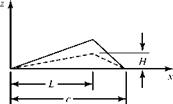Agreement of Thin-Airfoil Theory with Experimental Data
The value of any theory lies in its ability to accurately predict physical behavior. Even if a theory is simple, it is worthless if it cannot provide results that satisfactorily agree with experimental data. Thin-airfoil theory is examined from this viewpoint in Figs. 5.26 and 5.3.

![]()
Figure 5.25. Simple cambered airfoil.
Figure 5.26 shows the results of wind-tunnel tests on a NACA 0009 airfoil, which is a symmetrical airfoil with a 9 percent thickness ratio. The theory developed in Section 5.4 predicts that the lift-curve slope is 2n (per radian) and that the moment about the aerodynamic center is zero. The zero-moment prediction is exactly satisfied by the data because the moment coefficient lies exactly on the axis (for angles of attack in the range of -14 to +14°). The lift-curve slope is about 8.9 percent less than the theoretical value. Notice that two sets of data are shown. The lift coefficient versus the angle of attack with flap deflected shows the marked effect of camber on features such as the moment coefficient and aLo. This important effect is discussed in the next section. Flaps are the principal mechanism for generating control forces on airplanes.
 |
|
Figure 5.3 shows similar test results for a cambered four-digit NACA airfoil of 15 percent thickness ratio. The predicted behavior of this NACA 4415 airfoil can be obtained by using the results in Section 5.4. Because thin-airfoil theory addresses only the camber function, this is the only airfoil information we need. From Glauert (1926), the mean-camber-line function is given by:
where, for the NACA 4415 airfoil, t = 0.04 (4 percent) and x1 = 0.4 (40 percent). After differentiating and performing the integration in Eqs. 5.24 and 5.25:
A0 = 0.06083 for, say, a = 4°
A1 = 0.16299
The student should verify this result. Then, from Eq. 5.26:
Ct = n(2A0 + A0 = 0.894.
Compare this result with the experimental results in Fig. 5.3; the agreement is excellent. The experimental data also indicate that depending on Re, the aerodynamic center for the NACA 4415 airfoil is located at:
0. 241 < x < 0.245.
c
We recall from Eq. 5.33 that thin-airfoil theory predicts the aerodynamic center to be at x/c = 0.25 for any arbitrary airfoil.
Thin-airfoil theory should not be applied to airfoils with too large a thickness ratio because it is based on a zero-thickness model. Nature provides assistance in this regard because increases in lift due to thickness effects—which are predicted by more accurate inviscid theories—are not fully realized in practical applications due to viscous effects.
EXAMPLE 5.1 Given: Consider a thin airfoil with a mean camber line given by the equation:
where h is the maximum camber.
Required: Find aLo, Cmac, and xCp.
Approach: Use the appropriate equations from Section 5.4:
 |
Solution:
=— cosф. Substitute in Eq. 5.25 to find Ax and A2; then, use Eq. 5.34
. The result is:
Appraisal: The pitching moment is a restoring moment. Also, because the camber, z, has a length dimension, then K has a length dimension; when divided by the chord, the resulting moment is dimensionless, as it should be. For this airfoil with positive camber, the moment coefficient is negative, as it should be.











